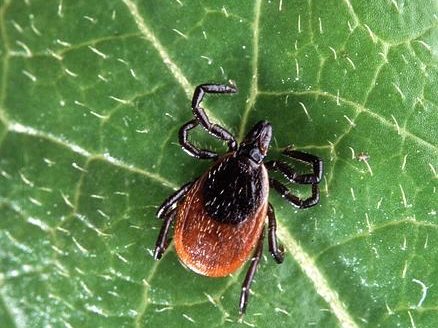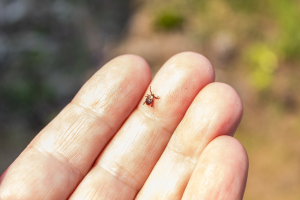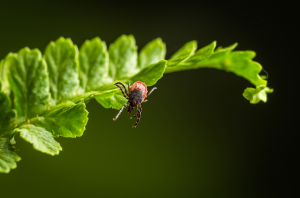What are ticks?
Anyone that lives in the south can tell you that these little bloodsuckers are all over the woods and swamps. The better question is how can you prevent ticks from being an issue for you!
Ticks are in the arachnid family. They have 8 legs and range in size from 3-5 mm long . These external parasites live by feeding on the blood of other animals such as mammals, birds, reptiles and even amphibians.
Where do ticks live?
Ticks live in grasses and plants where they can gain access to a “meal” They feed on the blood of other living creatures. Once full they will drop off their host and wait for another. If the tick is an adult female and has already mated she would then produce several thousand eggs that are about 2mm and appear translucent in shade of red or brown
Ticks are not able to fly or to jump, most tick species are sit and wait specialists. A tick will walk out to the end of a blade of grass or a branch in a position known as “questing”. While questing, a tick will hold onto the edges of leaves or grass by their third and fourth sets of legs. The tick will then stretch out its first set of legs, waiting to climb on to an unsuspecting host as it passes by.
“There are two families of ticks found in the United States: Ixodidae (hard ticks) and Argasidae (soft ticks). Of the 700 species of hard ticks and 200 species of soft ticks found throughout the world, only a few are known to bite and transmit disease to humans. Learn more about tick species, see photos, and learn the diseases they carry at https://www.lymedisease.org/types-of-ticks/ “
Do ticks spread disease?
There are a number of diseases ticks can carry and transmit. Lyme disease, Tick Fever, Rocky Mountain spotted fever and more. A bite from the Lone Star tick can cause you to develop an allergy to eating red meat. Learn more about these and others at https://www.cdc.gov/ticks/diseases/index.html
What are ticks attracted to?
The most common cause put forward is the amount and content of carbon dioxide exhaled from humans. Ticks are able to zoom in on this odor from quite a distance. Another suggestion links it to the warm temperature of the human body, along with perspiration.
Is there a repellent for ticks?
Permethrin and DEET are both effective in repelling ticks, but for different reasons and with different uses. Permethrin (not for use on skin) is a true insecticide that can repel, damage, or even kill small bugs. You can treat your clothing, backpacks and other cloth surfaces preventing the ticks from attaching and finding their way to you.
Another option that you can use on your skin is Gold Bond Powder – applying on neck, arms, waistline, and ankles before going into forest, tall grassy meadows, or on hiking trails will make you not as appealing. Ticks may still crawl on you but much less likely to attach where the powder was applied. You may even feel them trying to move away from that treated surface and remove before they have the opportunity to attach.
Ticks seem to hate the scent of Vicks Vapo Rub... Applying just a little Vicks on your bare ankles above your socks , some on your neck and a little applied to your waist and end of sleeves. They won't be able to “smell” your blood over the scent of the Vicks. Bonus: This has also helped keep mosquitoes away!
Natural options for repelling ticks
Ticks are repelled by the smell of citrus (lemon& orange), Ticks are also not fans of cinnamon, lavender, peppermint, or rose geranium . These scents are so offensive that they’ll avoid latching on to anything that smells of those items. A combination of these scents (such as is available in essential oils) can be used in DIY sprays or added to almond oil and rubbed on exposed skin.
Can ticks go through clothes?
They cannot go through tight woven or polyester fabrics. But they are pretty tough and we have found that ticks can survive the wash. This will allow them to attach to the insides of clothing while waiting on a host. It is wise to immediately wash your clothing when coming in from an area that ticks could be present and not let that clothing sit for a few days providing the opportunity to settle into your furniture, carpeting or pets.
To help protect yourself and your family, you should:
1. Use a chemical repellent with DEET, permethrin or picaridin.
2. Wear light-colored protective clothing that covers bare skin.
"Nymphal ticks are about the size of a poppy seed, so if you wear lighter-colored clothing like light socks, lighter-colored pants, you're going to have an easier time identifying them."
3. Tuck pant legs into socks when in areas that ticks are prone to be.
4. Avoiding tick-infested areas when possible.
5. Make sure to immediately check yourself, your children, and your pets daily for ticks. Ticks will most often attach in warm dark, moist spots on the host. Check neckline, ankles, waistline, armpits and groin area well. When coming in from outdoor activities where you may have come in contact with them. If you find a tick on you be sure to carefully remove them.
6. Shower soon after being outdoors.
Showering within 2 hours of outdoor activities has been shown to reduce the risk of getting Lyme disease and may be effective in reducing the risk of other tick borne diseases. Showering will help with washing off unattached ticks and it is the perfect time to do a tick check.
Click Here for Free Download Tips for Tick Safety
Don’t let the fear of ticks stop your outdoor adventures!
By following some of the above suggested precautions and being aware of what you should do when you arrive back home you should not have any issues with avoiding ticks.
It will generally take 4 hours for a tick to pass on a disease, and not all ticks carry a disease. Therefore it is s a good idea to check you and children for ticks every 2-3 hours. Remember to pay special attention to the areas ticks like - behind the ears, the scalp, and arm pits, behind knees, waistline and groin. Watch out for tiny tick nymphs, small little black speck easier to spot on light clothing Nymphs frequently transmit Lyme disease because they're very small and hard to notice right away.
We can help you with mosquitoes to! Check out our blog on Preventing Mosquito Bites
What will make a tick “back out”?
Once a tick is attached the head is close to the skins surface and the mouth parts have pierced the surface of the skin. When removing you have to be careful not to leave the head and mouth parts behind.
Do not try to cover it with petroleum jelly (in theory to suffocate it). Never try to use a hot match tip, nail polish remover, alcohol, or any other process that will encourage the tick to empty part of it meal back into you increasing the possibility of transferring disease. These are all supposed to make the tick “back out” of the skin on its own...
How to safely remove a tick
It is best to use fine-tipped tweezers to remove a tick. If you don't have tweezers, put on gloves or cover your hands with tissue paper, then use your fingers. Do not handle the tick with bare hands if it can be avoided.
• Carefully grab the tick as close to its mouth (the part that is stuck in your skin) as you can. The body of the tick will be above your skin. Do not grab the tick around its body as you could squeeze infected fluid from the tick into your body..
• Gently pull the tick straight out until its mouth lets go of your skin. Do not twist, just gently the tick straight out in the direction of its body. If part of the tick stays in the skin, leave it alone. It will likely come out on its own in a few days.
• Wash the area thoroughly with soap and water.
* If possible, save the tick. It may help doctors make a more accurate diagnosis in case of illness.
What do you do if you pull a tick out and the head stays in?
Tick's Head:
1. Clean the skin with rubbing alcohol. Attempt to remove by using a sterile needle to uncover the head and lift it out (like a splinter)
2. If a small piece of the head remains, the skin will slowly shed it.
3. If most of the head is left, call your doctor for help.
Watch the bite area for a few days. If the area becomes red and inflamed, you develop a rash, headache, joint pain, fever, or flu-like symptoms; this could mean you have an illness related to a tick bite. If you have any of these symptoms, or symptoms of a skin infection, call your doctor.




